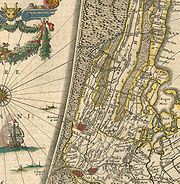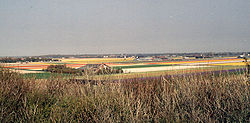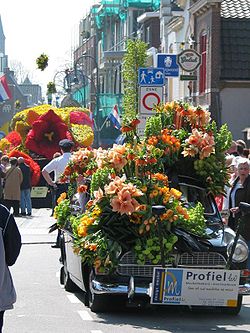
Duin- en Bollenstreek
Encyclopedia

South Holland
South Holland is a province situated on the North Sea in the western part of the Netherlands. The provincial capital is The Hague and its largest city is Rotterdam.South Holland is one of the most densely populated and industrialised areas in the world...
, The Netherlands
Netherlands
The Netherlands is a constituent country of the Kingdom of the Netherlands, located mainly in North-West Europe and with several islands in the Caribbean. Mainland Netherlands borders the North Sea to the north and west, Belgium to the south, and Germany to the east, and shares maritime borders...
, that features coastal dunes and the cultivation of flower bulbs
Bulb
A bulb is a short stem with fleshy leaves or leaf bases. The leaves often function as food storage organs during dormancy.A bulb's leaf bases, known as scales, generally do not support leaves, but contain food reserves to enable the plant to survive adverse conditions. At the center of the bulb is...
. Situated at the heart of historical Holland between Leiden and Haarlem
Haarlem
Haarlem is a municipality and a city in the Netherlands. It is the capital of the province of North Holland, the northern half of Holland, which at one time was the most powerful of the seven provinces of the Dutch Republic...
, the combination of beaches, flower fields, lakes and history makes this area attractive to tourists.
Composition and name
The Dune and Bulb Region stretches from the area around the lower reaches of the Old Rhine west of Leiden to just south of HaarlemHaarlem
Haarlem is a municipality and a city in the Netherlands. It is the capital of the province of North Holland, the northern half of Holland, which at one time was the most powerful of the seven provinces of the Dutch Republic...
. Since it is not a municipality or administrative region, the region's borders are not clearly defined. The Dune and Bulb Region proper is made up of the towns from Katwijk
Katwijk
Katwijk is a coastal municipality and town in the province of South Holland in the western Netherlands. It has a population of 61,292.-Location:...
to Hillegom
Hillegom
Hillegom is a town in the western Netherlands, in the province of South Holland. The municipality covers an area of 13.48 km² of which 0.61 km² is water....
, and from the coast to the Kaag Lakes. Officials consider six municipalities to be part of this region: Hillegom
Hillegom
Hillegom is a town in the western Netherlands, in the province of South Holland. The municipality covers an area of 13.48 km² of which 0.61 km² is water....
, Katwijk
Katwijk
Katwijk is a coastal municipality and town in the province of South Holland in the western Netherlands. It has a population of 61,292.-Location:...
, Lisse
Lisse
Lisse is a town and municipality in the western Netherlands, in the province of South Holland. The municipality covers an area of 16.11 km² of which 0.41 km² is water. Its population is 21864...
, Noordwijk
Noordwijk
Noordwijk is a town and municipality in the western Netherlands, in the province of South Holland. The municipality covers an area of 51.53 km² and had a population of 24,707 in May 2006....
, Noordwijkerhout
Noordwijkerhout
Noordwijkerhout is a town and municipality in the western Netherlands, in the province of South Holland. The municipality covers an area of 23.40 km² and had a population of 15,121 in May 2006...
and Teylingen
Teylingen
Teylingen is a municipality in the province of South Holland, the Netherlands. It was created on January 1, 2006, through the amalgamation of Sassenheim, Voorhout, and Warmond...
. However, towns just outside of these boundaries also consider themselves to be part of this region. Most of the towns in this area are in an administrative region called "Holland Rijnland", a regional collaboration (samenwerkingsverband) consisting of various municipalities in the Duin- en Bollenstreek and the Leiden area.
This area is the southern part of a larger flower-growing area called the Bulb Region (Bollenstreek
Bollenstreek
The Bollenstreek is a region in the Netherlands consisting of areas in North and South Holland that feature the cultivation of flower bulbs...
). However, it is not unusual for the Dune and Bulb Region itself to be referred to as the Bulb Region.
Geography of the area

Polder
A polder is a low-lying tract of land enclosed by embankments known as dikes, that forms an artificial hydrological entity, meaning it has no connection with outside water other than through manually-operated devices...
s (geestgrond), bulb fields and pasture land (weiland), all of which is protected from the North Sea
North Sea
In the southwest, beyond the Straits of Dover, the North Sea becomes the English Channel connecting to the Atlantic Ocean. In the east, it connects to the Baltic Sea via the Skagerrak and Kattegat, narrow straits that separate Denmark from Norway and Sweden respectively...
by an extensive dune area.
The climate and soil of the region are excellent for bulb cultivation. Proximity to the sea results in a substantial amount of rain.
The mild autumn and winter, the cool but sunny spring and the drier summer ensures a growing season lasting from the early spring to the late autumn.
Floriculture and the floral industry

Floriculture
Floriculture, or flower farming, is a discipline of horticulture concerned with the cultivation of flowering and ornamental plants for gardens and for floristry, comprising the floral industry...
, the processing of bulbs for export, and other activities in the floral industry
Floral industry
The floral industry is one of the major industries in many developing and underdeveloped countries. Floriculture as an industry began in the late 19th century in England, where flowers were grown on a large scale on the vast estates. The present day floral industry is a dynamic, global,...
are major economic activities in this area. Bulb cultivation in this area began at the end of the 16th century. Tulip mania
Tulip mania
Tulip mania or tulipomania was a period in the Dutch Golden Age during which contract prices for bulbs of the recently introduced tulip reached extraordinarily high levels and then suddenly collapsed...
in the early 17th century played a particularly important role in its development.
The bulbs are planted in the autumn. The earth is covered with straw and packed down to help protect the bulbs from the frost. The flower season begins with the flowering of crocus
Crocus
Crocus is a genus in the iris family comprising about 80 species of perennials growing from corms. Many are cultivated for their flowers appearing in autumn, winter, or spring...
es in March, followed at the end of March by the combined flowering of tulip
Tulip
The tulip is a perennial, bulbous plant with showy flowers in the genus Tulipa, which comprises 109 species and belongs to the family Liliaceae. The genus's native range extends from as far west as Southern Europe, North Africa, Anatolia, and Iran to the Northwest of China. The tulip's centre of...
s, narcissus (also known as daffodils) and hyacinth
Hyacinthus orientalis
Hyacinthus orientalis , is a perennial flowering plant, native to southwestern Asia, southern and central Turkey, northwestern Syria, Lebanon and northern Israel. It was introduced to Europe in the 16th century.It is a bulbous plant, with a 3–7 cm diameter bulb...
s, which extends into early May. In the autumn, a further display occurs when gladioli
Gladiolus
Gladiolus is a genus of perennial bulbous flowering plants in the iris family...
, dahlia
Dahlia
Dahlia is a genus of bushy, tuberous, perennial plants native to Mexico, Central America, and Colombia. There are at least 36 species of dahlia, some like D. imperialis up to 10 metres tall. Dahlia hybrids are commonly grown as garden plants...
s, carnation
Carnation
Dianthus caryophyllus is a species of Dianthus. It is probably native to the Mediterranean region but its exact range is unknown due to extensive cultivation for the last 2,000 years. It is the wild ancestor of the garden carnation.It is a herbaceous perennial plant growing to 80 cm tall...
s and asters flower.
These flowers are often grown primarily for the bulb, not the flower. After they have bloomed, the flowers are decapitated. The flower may be used in floral wreaths. In the summer the bulbs are dug out and the plant remains are burned in the fields. The bulbs are sorted, the bulbs large enough to flower being sold and the smaller bulbs replanted. The bulbs are peeled, usually by students or foreign workers. They are then disinfected and dried out at a high temperature in huge bulb sheds (bollenschuren), a characteristic building in this area. The bulbs are traded at flower auctions in Rijnsburg
Rijnsburg
Rijnsburg is a community in the eastern part of the city Katwijk, in the western Netherlands, in the province of South Holland. The name means Rhines Burg in Dutch.-History:...
, Lisse
Lisse
Lisse is a town and municipality in the western Netherlands, in the province of South Holland. The municipality covers an area of 16.11 km² of which 0.41 km² is water. Its population is 21864...
and Aalsmeer
Aalsmeer
Aalsmeer is a municipality and a town in the Netherlands, in the province of North Holland. Its name is derived from the Dutch for eel and lake . Aalsmeer is bordered by the Westeinderplassen lake, the largest open water of the Randstad, and the Ringvaart Canal...
and then exported from nearby Schiphol Airport to many countries throughout the world.
Attractions

Keukenhof
Keukenhof , also known as the Garden of Europe, is situated near Lisse, Netherlands, and is the world's largest flower garden...
in particular attracts 700,000 visitors every year. The combination of flowers, windmills, quaint villages and Dutch charm is irresistible. The people in this area are in the flower business and make no apologies for it.
There are a few "flower parades" (bloemencorso
Bloemencorso
Bloemencorso means "flower parade", "flower pageant" or "flower procession". In a parade of this kind the floats , cars and boats are magnificently decorated or covered in flowers. Each parade has its own character, charm and theme...
) in this area. One of them is the Bloemencorso Bollenstreek in April, during which floral floats, magnificently decorated cars and marching bands parade slowly from Noordwijk aan Zee through Sassenheim
Sassenheim
Sassenheim is a town and former municipality in the western Netherlands, in the province of South Holland.The former municipality covered an area of 6.62 km² and had a population of 14,906 in 2005...
, Lisse
Lisse
Lisse is a town and municipality in the western Netherlands, in the province of South Holland. The municipality covers an area of 16.11 km² of which 0.41 km² is water. Its population is 21864...
, Hillegom
Hillegom
Hillegom is a town in the western Netherlands, in the province of South Holland. The municipality covers an area of 13.48 km² of which 0.61 km² is water....
, Heemstede
Heemstede
Heemstede is a municipality and a town in the Netherlands, in the province of North Holland.-History :Heemstede formed around the Castle Heemstede that was built on the Spaarne River around 1286. Before 1296, Floris V, Count of Holland, granted Heemstede as a fiefdom to Reinier of Holy...
to Haarlem
Haarlem
Haarlem is a municipality and a city in the Netherlands. It is the capital of the province of North Holland, the northern half of Holland, which at one time was the most powerful of the seven provinces of the Dutch Republic...
. In August there is another flower parade from Leiden through Rijnsburg
Rijnsburg
Rijnsburg is a community in the eastern part of the city Katwijk, in the western Netherlands, in the province of South Holland. The name means Rhines Burg in Dutch.-History:...
to Katwijk aan Zee
Katwijk aan Zee
Katwijk aan Zee is a seaside resort located on the North Sea at the mouth of the Oude Rijn. It is situated in the municipality of Katwijk and the province of South Holland.- History :...
.
Other attractions in the region include:
-
-
-
-
-
-
-
-
-
-
- the clean, wide beaches extending along the entire coast
-
-
-
-
-
-
-
-
-
-
-
-
-
-
-
-
-
-
-
- the beach resorts, especially at Noordwijk aan Zee
-
-
-
-
-
-
-
-
-
-
-
-
-
-
-
-
-
-
-
- extensive coastal dune area (walking, cycling)
-
-
-
-
-
-
-
-
-
-
-
-
-
-
-
-
-
-
-
- the KaagKaagDe Kaag is a village in the Dutch province of South Holland. It is a part of the municipality of Kaag en Braassem, and lies about 8 km northeast of Leiden.De Kaag lies on an island, Kagereiland, in a lake system called the Kaag Lakes...
lakes just to the east of the area (boating, Dutch landscape, windmills)
- the Kaag
-
-
-
-
-
-
-
-
-
-
-
-
-
-
-
-
-
-
-
- two castles (Huys Dever and Slot Teylingen) and various grand manor houses
-
-
-
-
-
-
-
-
-
-
-
-
-
-
-
-
-
-
-
- museums (De Zwarte Tulp, Panorama Tulipland, Museum Oud-Noordwijk, Katwijk Museum, the Space Expo at ESTEC and others)
-
-
-
-
-
-
-
-
-
-
-
-
-
-
-
-
-
-
-
- the attractive and historic village centres
-
-
-
-
-
-
-
-
-
-
-
-
-
-
-
-
-
-
-
- proximity to Leiden and Haarlem and, a little further afield, Amsterdam, The Hague and Delft
-
-
-
-
-
-
-
-
-
Towns and villages


- De Engel
- De KaagKaagDe Kaag is a village in the Dutch province of South Holland. It is a part of the municipality of Kaag en Braassem, and lies about 8 km northeast of Leiden.De Kaag lies on an island, Kagereiland, in a lake system called the Kaag Lakes...
- De Zilk
- HillegomHillegomHillegom is a town in the western Netherlands, in the province of South Holland. The municipality covers an area of 13.48 km² of which 0.61 km² is water....
- Katwijk aan ZeeKatwijk aan ZeeKatwijk aan Zee is a seaside resort located on the North Sea at the mouth of the Oude Rijn. It is situated in the municipality of Katwijk and the province of South Holland.- History :...
- KatwijkKatwijkKatwijk is a coastal municipality and town in the province of South Holland in the western Netherlands. It has a population of 61,292.-Location:...
- KeukenhofKeukenhofKeukenhof , also known as the Garden of Europe, is situated near Lisse, Netherlands, and is the world's largest flower garden...
- Langevelderslag
- LisseLisseLisse is a town and municipality in the western Netherlands, in the province of South Holland. The municipality covers an area of 16.11 km² of which 0.41 km² is water. Its population is 21864...
- LimmenLimmenLimmen is a town in the Dutch province of North Holland. It is a part of the municipality of Castricum, and is situated about 9 km southwest of Alkmaar. Before 2002 it was a separate municipality....
- LisserbroekLisserbroekLisserbroek is an unincorporated village town in the Dutch province of North Holland. It is a part of the municipality of Haarlemmermeer, and lies about 10 km southwest of Hoofddorp. It is located along the Ringvaart opposite the town of Lisse in the area called the "Dune and Bulb Region"...
- NoordwijkNoordwijkNoordwijk is a town and municipality in the western Netherlands, in the province of South Holland. The municipality covers an area of 51.53 km² and had a population of 24,707 in May 2006....
- Noordwijk aan Zee
- NoordwijkerhoutNoordwijkerhoutNoordwijkerhout is a town and municipality in the western Netherlands, in the province of South Holland. The municipality covers an area of 23.40 km² and had a population of 15,121 in May 2006...
- OegstgeestOegstgeestOegstgeest is a town and municipality in the province of South Holland in the western Netherlands. Its population was 22,576 in 2008.-Location :...
- RijnsburgRijnsburgRijnsburg is a community in the eastern part of the city Katwijk, in the western Netherlands, in the province of South Holland. The name means Rhines Burg in Dutch.-History:...
- SassenheimSassenheimSassenheim is a town and former municipality in the western Netherlands, in the province of South Holland.The former municipality covered an area of 6.62 km² and had a population of 14,906 in 2005...
- TeylingenTeylingenTeylingen is a municipality in the province of South Holland, the Netherlands. It was created on January 1, 2006, through the amalgamation of Sassenheim, Voorhout, and Warmond...
- VoorhoutVoorhoutthumb|250px|right|Location of Voorhout.Voorhout is a town and former municipality in the western Netherlands, in the province of South Holland. The former municipality covered an area of 12.59 km² of which 0.33 km² is covered by water, and had a population of 14,792 in 2004...
- WarmondWarmondWarmond is a village and former municipality in the western Netherlands, north of Leiden in the province of South Holland. The municipality covered an area of 14.42 km² of which 4.42 km² is water, and had a population of 4,977 in 2004. Together with Sassenheim and Voorhout, it became...

